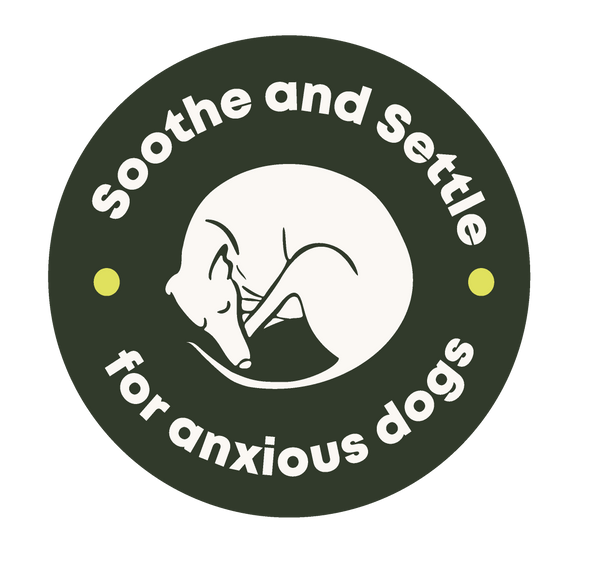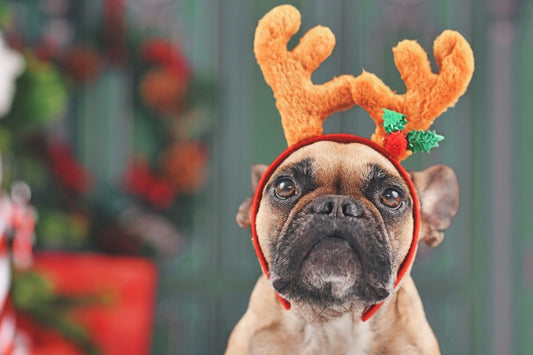
Your Ultimate Guide to Travelling with an Anxious Dog
Share
We love travelling with our pets, but for some dogs, it can be a source of stress and anxiety. Whether it's a car ride to the vet or a longer trip, understanding and managing your dog's travel anxiety is essential for a stress-free experience for the both of you.
In this guide, we’ll help you to understand what travel anxiety is, why some dogs get anxious when travelling, and some practical tips to help your pup overcome their fears.
What is Travel Anxiety?
Travel anxiety in dogs refers to the stress, fear, or nervousness that some dogs experience when travelling from one place to another. This can manifest in several different ways, but some common signs your dog may be feeling anxious about travelling include:
- Drooling or excessive salivation
- Pacing or restlessness
- Excessive panting
- Trembling
- Whining
- Hiding
- Licking and biting
- Tail between legs
- Flattened ears
- Vomiting or diarrhoea
Why Dogs Get Anxious When Travelling
Before implementing strategies to help your dog with travel, it’s important to understand why some dogs get anxious when travelling. Travel anxiety in dogs often stems from the fear of not understanding what is happening, but there are some other common reasons why your dogs might get anxious before, during or after a trip:
- Motion Sickness: Just like humans, some dogs can experience motion sickness. The feeling of being in a moving vehicle can cause nausea, discomfort, and stress, making them reluctant to get in the car or on other forms of transport.
- Senses: The sights, sounds, and smells of travelling can be overwhelming for some dogs, in particular if they are sensitive to new stimuli. Busy roads, loud noises, and unfamiliar environments can all contribute to anxious behaviour.
- Lack of Exposure: Dogs who haven't been exposed to different environments, people and experiences during their critical socialisation period (before 14 weeks) can be more prone to anxiety when faced with new situations.
- Negative Experience: A single traumatic event involving travel, or repeated exposure to frightening experiences when travelling, can cause mild fear to extreme phobic reactions in dogs.
- Separation Anxiety: If a dog is travelling without their owner or being placed in unfamiliar surroundings, they might experience separation anxiety — when dogs become upset because of separation from their guardian, leading to separation-related behaviours such as chewing or destroying furniture, howling, barking or whining, and other anxious behaviours.
How to Get a Puppy Used to Travel
The best way to prevent a fear of travelling in dogs is to expose them to travel when they are young. As a general rule of thumb, you should make sure your dog is relaxed or engaged in positive behaviours before you expose them to new situations.
You can start by using your puppy or dog’s favourite special treats to reward them for being calm whenever they’re near the car. Then, take short, slow and gentle journeys that will allow your dog to get used to car travel.
If your dog is apprehensive about getting in the car, a blanket or pillow from your home could reassure them and encourage them to get in.
You should observe your puppy's behaviour closely during exposure and make sure you stop if they seem distressed during a session.
 A car seat or carrier, complete with a blanket and toys can help provide a secure and confined space for your dog.
A car seat or carrier, complete with a blanket and toys can help provide a secure and confined space for your dog. How to Help Anxious Dogs With Travel
If your dog shows signs of anxiety before, during or after travel, here’s how you can help them cope.
Before Travel
Prepare Your Pup
Training
Desensitisation and counterconditioning are behaviour modification techniques used to help dogs overcome fear. The goal is to expose your dog to the feared stimulus (in this case, travel) at a low intensity while pairing it with something positive, such as treats or playtime.
Another effective method to keep dogs calm during loud noises is relaxation training. This is where owners induce relaxation, and then associate this with a word to classically condition a calm physiological state. This can then be used before, during or after travel to induce relaxation
Create a Comfortable Space
Use Aromatherapy
Essential oils that are safe for dogs, such as lavender or chamomile, can have a calming effect on dogs.
You can use these in a diffuser or a spray to create a calming environment in the car before they get in, or as part of a light massage before travel - just make sure to follow safety precautions before using essential oils on or around your pets.
Avoid Food
If you know that your dog gets motion sickness, avoid feeding them before going in the car.
You should withhold food for at least an hour before you travel as an empty stomach will help reduce nausea and the risk of vomiting.
During Travel
Stay Calm
If your dog is reacting to travel, make sure you stay calm and follow your normal routine.
If you tell your dog off or behave in a way that is different from usual, this can make them feel more anxious and distressed.
Practise Positive Reinforcement
Rewarding relaxed behaviours, such as staying calm in the car, can help your dog during travel. Give your dog a treat for settling down in the car without saying anything to them.
Over time, you can build up distractions by practising the ‘settle’ in different travel scenarios, to teach your dog to relax and settle without needing to be asked.
Use a Hush Muff
Using ear or head coverings can help to reduce exposure to loud noises and calm your dog down.
At Soothe and Settle, we have created The Hush Muff, an anti-anxiety head covering with a unique, registered design, that is tailored to fit snugly around your dog's head.
As well as muffling the impact of sudden loud noises when travelling, it wraps your pet in a gentle embrace for an additional sense of comfort.
 As well as muffling the impact of sudden loud noises when travelling, The Hush Muff wraps your pet in a gentle embrace for an additional sense of comfort.
As well as muffling the impact of sudden loud noises when travelling, The Hush Muff wraps your pet in a gentle embrace for an additional sense of comfort.Play Calming Music
Music can have a therapeutic effect on dogs. Try playing calming music - such as soft classical music or dog soundtracks - to help soothe and calm an anxious pup in the car.
PetMD recommends Preventive Vet on Spotify for different pet-friendly playlists, or doing a search on YouTube for the top relaxing dog music videos.
It’s recommended that you introduce these sounds in a comfortable and positive environment before you travel so that your dog associates the sound with calm.
Take Regular Breaks
If you’re making a long trip, make sure to build it up gradually weeks in advance.
When on the trip, stop every couple of hours to let your pup stretch their legs, play and go to the toilet.
Don't Leave Your Dog Alone
Don't leave your dog in the car unattended, even on cooler days.
As well as the risk of heatstroke and dehydration, leaving your dog alone can make them feel trapped and abandoned, which will make their anxiety worse.
After Travel
Create a Safe Space
Once you reach your destination, create a familiar and comfortable space for your dog to allow them time to adjust to the new environment. This can be made with bedding, blankets and toys brought from home which will smell familiar and help reassure them.
Spend Quality Time Together
To help your dog unwind from travelling, spend quality time together with lots of love and cuddles. This can also help them to relax if you have travelled to an unfamiliar environment.
Conclusion
By recognising the signs of travel anxiety, identifying the reasons behind it, and implementing practical strategies to help your dog cope, you can ensure a stress-free and enjoyable journey for all.
Remember, patience, consistency, and positive reinforcement are crucial, in particular as what works for one dog might not work for the other. However, through trying out the strategies outlined in this guide, you can help your dog overcome their travel anxiety and enjoy the adventures ahead.
Why not try out The Hush Muff? The original anti-anxiety muff is designed to help dogs prone to anxiety or nervousness in stressful situations, including travel, fireworks and other loud noises.
Tailored to fit snugly around your dog's head, The Hush Muff not only muffles the impact of sudden noises but also wraps your pet in a gentle embrace for a sense of security and comfort.
It's available in over 10 different designs, and works for small to extra large dogs of all breeds - check out our size guide for more information on which one is right for your dog.






